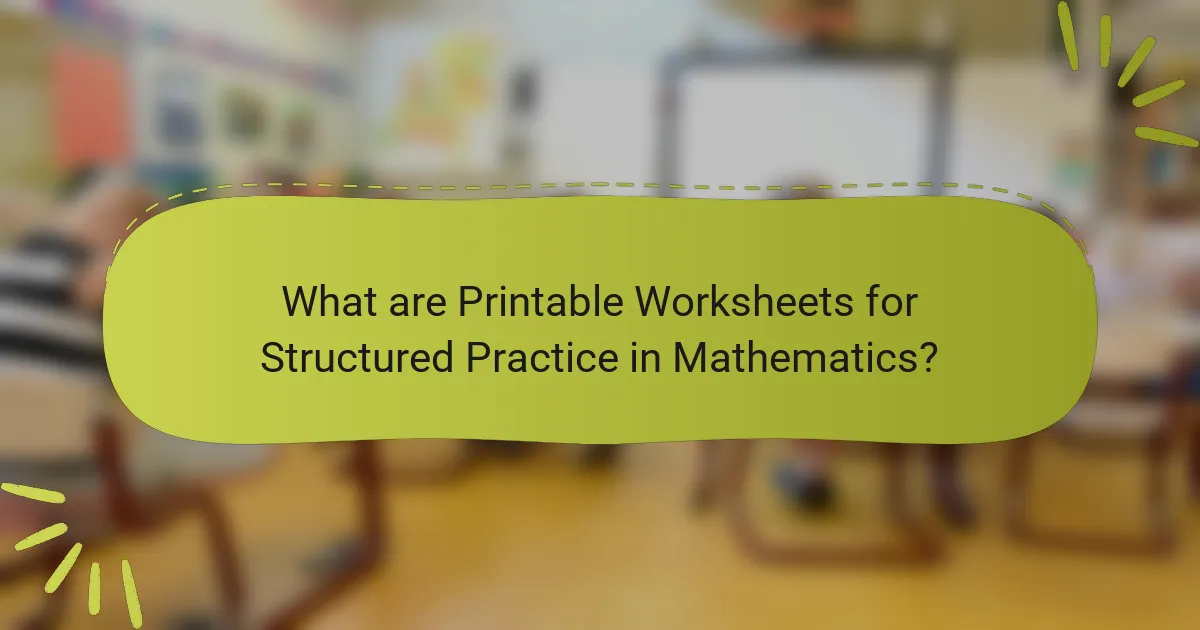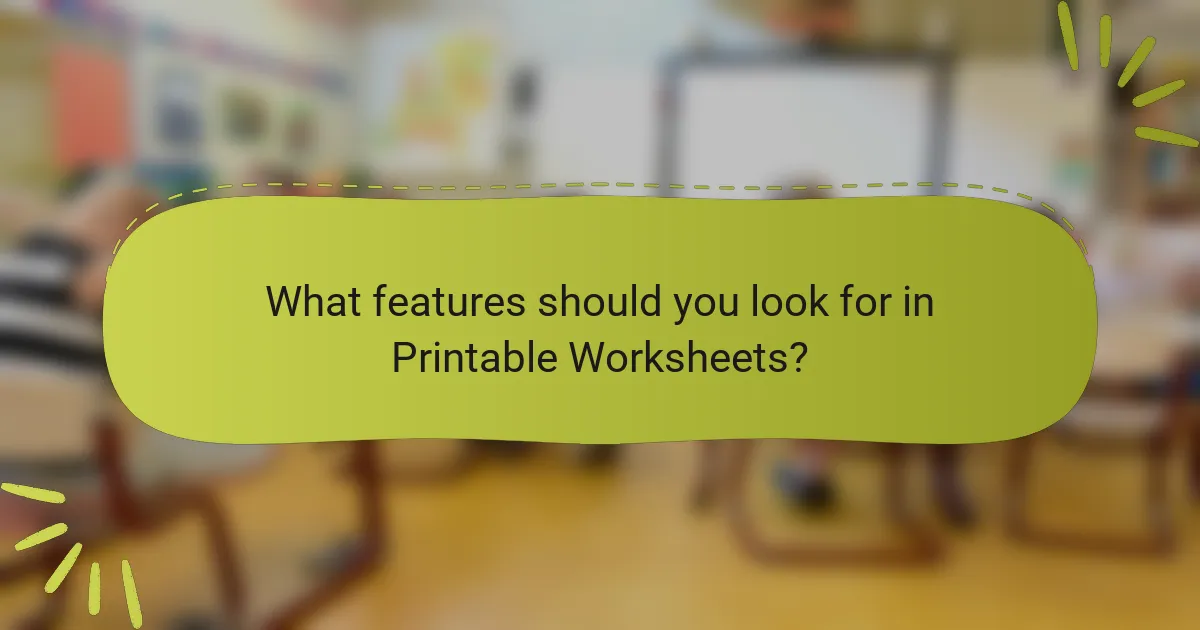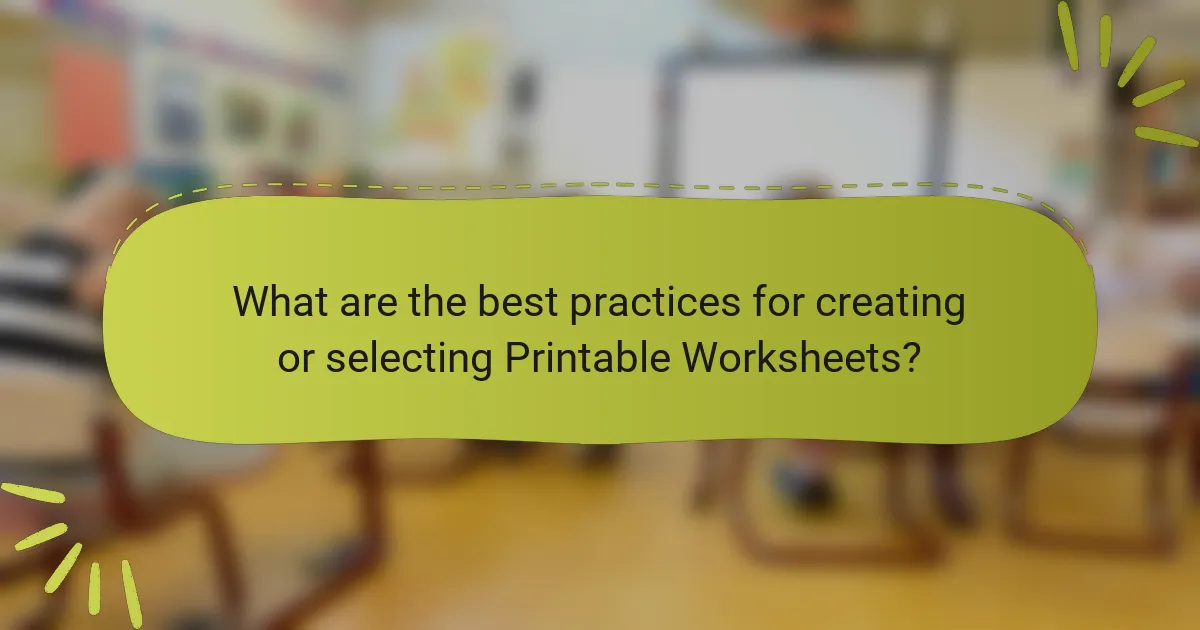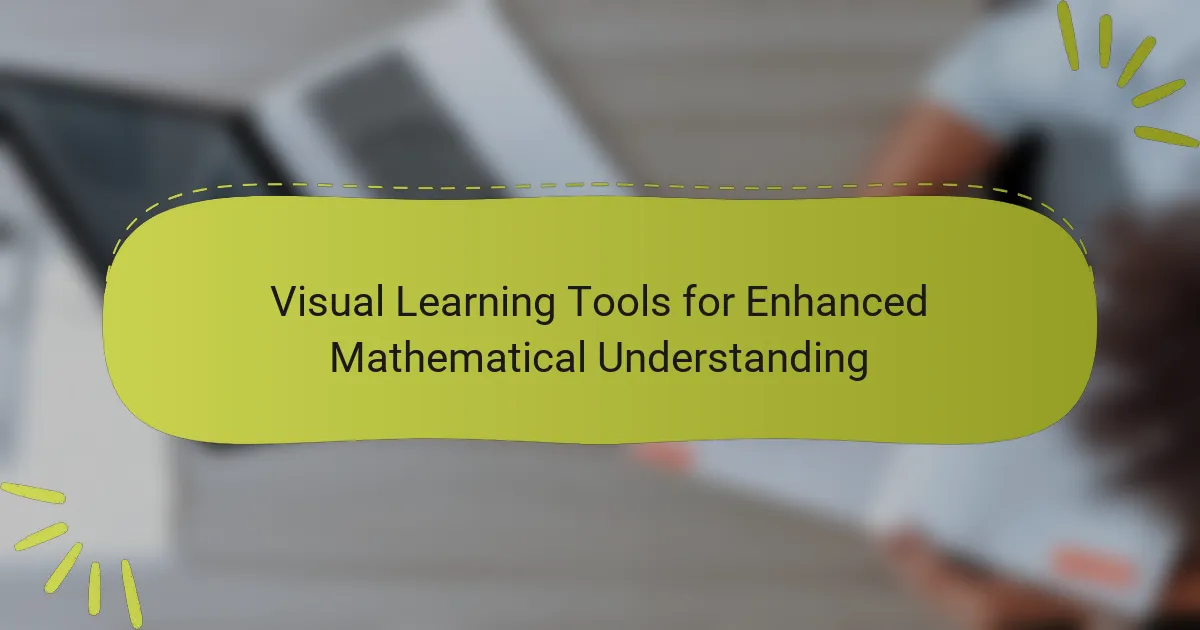Printable worksheets for structured practice in mathematics are educational tools that provide systematic exercises designed to enhance student learning and mastery of mathematical concepts. These worksheets cover fundamental topics such as addition, subtraction, multiplication, and division, and are organized by difficulty to accommodate diverse learners. Key features of effective worksheets include clarity in instructions, relevance to curriculum standards, engaging visual designs, and a variety of question types to cater to different learning styles. Best practices for creating or selecting these worksheets emphasize alignment with educational goals, appropriate challenge levels, and mechanisms for self-assessment, ensuring that they effectively reinforce skills and improve student performance in mathematics.

What are Printable Worksheets for Structured Practice in Mathematics?
Printable worksheets for structured practice in mathematics are educational tools designed to facilitate learning. They provide a systematic approach to practicing mathematical concepts. These worksheets typically include exercises on various topics, such as addition, subtraction, multiplication, and division. They are often organized by difficulty level to cater to different learners. Educators use these worksheets to reinforce skills and assess student understanding. Research indicates that structured practice enhances retention and mastery of mathematical skills. Studies show that students who engage with worksheets demonstrate improved performance in assessments.
How do Printable Worksheets enhance mathematical learning?
Printable worksheets enhance mathematical learning by providing structured practice opportunities. They allow students to engage with mathematical concepts in a systematic way. Worksheets can target specific skills, such as addition, subtraction, or problem-solving. This targeted practice reinforces understanding and retention of mathematical principles. Research indicates that regular practice through worksheets improves student performance in mathematics. A study by the National Mathematics Advisory Panel found that practice is essential for mastery in math. Worksheets also offer immediate feedback, helping students identify and correct mistakes. This feedback loop promotes self-assessment and encourages independent learning. Overall, printable worksheets are effective tools for enhancing mathematical learning through structured and focused practice.
What types of skills can be developed using these worksheets?
Printable worksheets for structured practice in mathematics can help develop various skills. These skills include problem-solving abilities, critical thinking, and analytical reasoning. Worksheets often focus on specific mathematical concepts, enhancing computational skills and numerical fluency. They can also improve students’ understanding of mathematical vocabulary and terminology. Additionally, worksheets promote organizational skills as students learn to structure their work. They encourage perseverance and resilience through practice and repetition. Overall, these worksheets serve as effective tools for building foundational math skills essential for academic success.
How do Printable Worksheets cater to different learning styles?
Printable worksheets cater to different learning styles by providing diverse formats and activities. Visual learners benefit from colorful diagrams and charts included in worksheets. Auditory learners can engage with instructions read aloud or incorporated into the activities. Kinesthetic learners find hands-on tasks, such as puzzles and cut-out activities, effective for their learning. Worksheets often include a variety of question types, such as multiple-choice, fill-in-the-blank, and open-ended questions. This variety allows learners to approach the material in ways that suit their preferences. Research shows that catering to different learning styles enhances retention and understanding. For example, a study by Pashler et al. (2008) emphasizes the importance of accommodating various learning preferences to improve educational outcomes.
Why are Printable Worksheets important in mathematics education?
Printable worksheets are important in mathematics education because they provide structured practice opportunities. They help reinforce mathematical concepts through repetition and application. Worksheets can be tailored to different skill levels, ensuring that all students engage with appropriate material. They facilitate independent learning, allowing students to practice at their own pace. Research indicates that regular practice enhances retention and understanding of mathematical principles. Studies show that students who use worksheets score higher on assessments, demonstrating their effectiveness. Additionally, printable worksheets can be easily integrated into various teaching methods, making them versatile educational tools.
What role do they play in reinforcing concepts?
Printable worksheets play a crucial role in reinforcing concepts in mathematics. They provide structured practice that helps students apply learned skills. Worksheets often include a variety of problems that target specific mathematical concepts. This repetition aids in solidifying understanding and retention of material. Research shows that practice enhances performance in mathematics (National Mathematics Advisory Panel, 2008). Additionally, worksheets facilitate immediate feedback, allowing students to identify and correct mistakes. This process further strengthens their grasp of mathematical principles. Overall, printable worksheets serve as effective tools for concept reinforcement in mathematics education.
How do they support individualized learning?
Printable worksheets for structured practice in mathematics support individualized learning by allowing students to work at their own pace. They provide tailored exercises that cater to different skill levels. Each worksheet can focus on specific concepts, enabling targeted practice. This customization helps address individual learning gaps. Additionally, worksheets can be used for reinforcement or advanced challenges as needed. Teachers can assign different worksheets based on assessment results. This approach fosters a personalized learning environment. Research indicates that individualized practice improves student engagement and understanding in mathematics.

What features should you look for in Printable Worksheets?
Look for clarity, organization, and relevance in printable worksheets. Clarity ensures that instructions and questions are easily understood. Organization helps in logically presenting information, making it easier for students to follow. Relevance ensures that the content aligns with the curriculum and learning objectives.
Additionally, consider visual appeal, as engaging designs can enhance student interest. Worksheets should also include a variety of question types to accommodate different learning styles. Lastly, ensure that answer keys are provided for self-assessment. These features collectively promote effective learning and practice in mathematics.
What types of content are typically included in these worksheets?
Printable worksheets for structured practice in mathematics typically include problem sets, exercises, and quizzes. Problem sets often focus on specific mathematical concepts, such as addition, subtraction, multiplication, or division. Exercises may involve word problems, visual representations, or equations requiring solutions. Quizzes are designed to assess understanding and retention of the material covered. Additionally, these worksheets may feature instructional content, such as explanations of concepts or step-by-step problem-solving strategies. They often include answer keys to facilitate self-assessment.
How do problem types vary across different grade levels?
Problem types vary across different grade levels by increasing complexity and abstraction. In early grades, problems often focus on basic arithmetic and concrete concepts. For example, first graders might solve simple addition and subtraction problems using visual aids. As students progress to middle grades, they encounter multi-step problems and the introduction of fractions and decimals. High school students face more abstract concepts, such as algebra and geometry, requiring critical thinking and problem-solving skills. Research shows that problem types evolve to align with cognitive development stages, reflecting increasing mathematical understanding. This progression ensures that worksheets are tailored to each grade level’s learning objectives and cognitive abilities.
What formats are available for Printable Worksheets?
Printable worksheets are available in several formats. Common formats include PDF, Word documents, and image files like JPEG or PNG. PDF is widely used due to its compatibility across devices. Word documents allow for easy editing and customization. Image files are often used for visual content. Each format serves different needs, making them versatile for educational purposes.
How can Printable Worksheets be effectively utilized in the classroom?
Printable worksheets can be effectively utilized in the classroom by providing structured practice for students. They help reinforce mathematical concepts through repetition and application. Worksheets can be tailored to different skill levels, ensuring that all students are engaged. Teachers can use them for individual practice, group activities, or homework assignments. This versatility allows for a variety of teaching methods. Additionally, worksheets can include visual aids and problem-solving exercises to enhance understanding. Research shows that consistent practice improves retention and mastery of mathematical skills. Effective use of printable worksheets can lead to better academic outcomes in mathematics.
What strategies enhance student engagement with these worksheets?
Incorporating interactive elements enhances student engagement with printable worksheets. Interactive elements include puzzles, games, and quizzes. These features make learning enjoyable and motivate students to participate actively. Utilizing real-world examples connects math concepts to everyday life. This relevance increases student interest and understanding. Providing immediate feedback on exercises helps students recognize their progress. This feedback loop encourages persistence and improvement. Group activities foster collaboration among students. Collaborative learning enhances engagement through peer interaction. Lastly, varying worksheet formats keeps the material fresh and engaging. This variety caters to different learning styles and maintains student attention.
How can teachers assess student understanding using Printable Worksheets?
Teachers can assess student understanding using printable worksheets by evaluating the accuracy of student responses. Worksheets can include a variety of question types, such as multiple-choice, short answer, and problem-solving tasks. Each type of question targets specific skills and knowledge areas.
By analyzing the responses, teachers can identify areas of strength and weakness in student comprehension. For instance, a high percentage of correct answers indicates mastery of the topic. Conversely, frequent errors point to concepts that need further instruction.
Additionally, worksheets can be graded for completion and effort, providing a holistic view of student engagement. Tracking performance over time with different worksheets helps in measuring progress. This method aligns with best practices in formative assessment, which emphasizes ongoing feedback.

What are the best practices for creating or selecting Printable Worksheets?
The best practices for creating or selecting printable worksheets include clarity, relevance, and engagement. Worksheets should have clear instructions and objectives. Each worksheet should focus on specific mathematical concepts to ensure relevance. Engaging visuals and varied question formats can enhance student interest. Additionally, worksheets should be appropriately challenging to match students’ skill levels. Incorporating feedback mechanisms allows for assessment of understanding. Using established educational standards ensures alignment with learning goals. Finally, testing worksheets with a small group can provide insights into their effectiveness.
How can you ensure worksheets align with educational standards?
To ensure worksheets align with educational standards, first identify the relevant standards for your subject and grade level. Review documents such as the Common Core State Standards or state-specific guidelines. Next, design worksheets that incorporate the key concepts and skills outlined in these standards. Use clear objectives for each worksheet, ensuring they directly reflect the standards. Additionally, include assessment criteria that measure student understanding of these objectives. Finally, seek feedback from educators or curriculum specialists to validate alignment with the standards. This process is crucial for effective educational practices.
What criteria should you use to evaluate worksheet quality?
To evaluate worksheet quality, focus on clarity, relevance, and engagement. Clarity ensures instructions and content are understandable. Relevance guarantees the worksheet aligns with educational standards and learning objectives. Engagement involves the use of interactive elements that motivate students. Additionally, accuracy is crucial; all mathematical content must be correct. Variety in question types enhances critical thinking. Finally, visual appeal contributes to overall effectiveness. These criteria collectively ensure that worksheets facilitate structured practice effectively.
How can you customize Printable Worksheets for diverse learners?
To customize printable worksheets for diverse learners, tailor content to meet varying needs. Use different formats, such as visual aids for visual learners. Incorporate varying levels of difficulty to challenge advanced students while supporting those who need more practice. Include clear instructions and examples to enhance understanding. Utilize color coding to differentiate sections and highlight key concepts. Add interactive elements, like puzzles or games, to engage learners. Provide alternative formats, such as digital versions, for accessibility. Research shows that differentiated instruction improves learning outcomes for diverse student populations.
What resources are available for finding high-quality Printable Worksheets?
High-quality printable worksheets can be found on various educational websites. Websites like Teachers Pay Teachers offer a wide range of user-created resources. Education.com provides worksheets across multiple subjects, including math. Scholastic also has a selection of printable worksheets for different grade levels. Additionally, websites like K5 Learning specialize in math worksheets for elementary students. The Math Salamanders site features free math worksheets for various topics. Each of these platforms allows users to search by grade level and subject matter. These resources are widely used by educators and parents for structured practice in mathematics.
What websites offer free or paid Printable Worksheets?
Websites that offer free or paid printable worksheets include Education.com, Teachers Pay Teachers, and Scholastic. Education.com provides a variety of free worksheets across subjects, including mathematics. Teachers Pay Teachers features user-created worksheets, some of which are free while others are paid. Scholastic offers both free resources and paid materials for educators and parents. Each of these websites is widely recognized for their educational resources.
How can educators collaborate to share effective worksheets?
Educators can collaborate to share effective worksheets by utilizing online platforms and social media groups. These platforms allow teachers to upload and download resources easily. For example, websites like Teachers Pay Teachers enable sharing among a large community. Additionally, educators can create shared drives or cloud storage folders for direct access to materials. Regular meetings or workshops can also facilitate the exchange of ideas and resources. Research shows that collaboration enhances teaching effectiveness and student outcomes. According to a study by Vescio, Ross, and Adams (2008), collaborative practices in education lead to improved instructional strategies.
What tips can help maximize the effectiveness of Printable Worksheets?
To maximize the effectiveness of printable worksheets, ensure they are aligned with learning objectives. Worksheets should target specific skills or concepts in mathematics. Include clear instructions to guide students through exercises. Use engaging visuals to maintain student interest and enhance understanding. Incorporate a variety of question types to cater to different learning styles. Provide space for students to show their work, which encourages critical thinking. Regularly assess the completed worksheets to provide feedback and reinforce learning. Studies show that structured practice improves retention and mastery of mathematical concepts.
Printable worksheets for structured practice in mathematics are essential educational tools that facilitate systematic learning of mathematical concepts, including addition, subtraction, multiplication, and division. These worksheets cater to diverse learning styles and skill levels, providing targeted practice that enhances problem-solving abilities and critical thinking. The article explores the importance of printable worksheets in reinforcing mathematical understanding, the types of skills they develop, and best practices for creating or selecting high-quality worksheets. Additionally, it discusses how these resources support individualized learning and improve student engagement and performance in mathematics.



